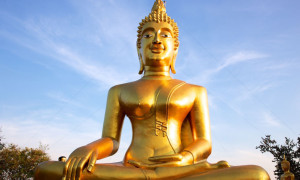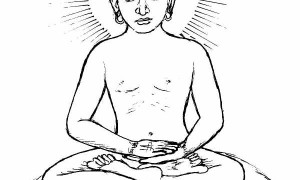“Calming the bodily-formation. ‘I’ shall breathe out,” thus he trains himself;
“Calming the bodily-formation, ‘I’ shall breathe in,” thus he trains himself.
Buddha, Anapanasati Sutta
Explanation of Anapanasati Stage Four by Buddhadasa Bhikkhu
Breathing is very closely co-ordinated with the rest of the body, being the source of a variety of bodily phenomena such as temperature, movement, flexibility, and so on. Breathing and body are interrelated, influencing each other mutually as to grossness or fineness, restlessness or calmness, and so on. As may be seen, when the body is stiff or restless the breathing tends to be likewise gross or restless, conversely when the breathing is fine and calm the body tends to become flexible and calm as well. So to control the body is to control the breathing; and conversely, to control the breathing is to control the body. When the breathing is fine, the body is tender and flexible. It is in no way stiff, painful, or restless. This observation, besides revealing the close relationship existing between body and breathing, indicates the value of taking into consideration both body and breathing, training them simultaneously so that they may calm each other mutually.
This observation, besides revealing the close relationship existing between body and breathing, indicates the value of taking into consideration both body and breathing, training them simultaneously so that they may calm each other mutually.
One point needs to be stressed, in this connection. The normal breathing (before beginning to practise) is conventionally termed gross or fine, calm or restless; irrespective of the state of the body. But, regardless of how fine and calm the normal or natural breathing may be, it must, in terms of the practice, be regarded as still gross. It will become truly subtle and calm through the meditation practice, and it is precisely that process that constitutes Stage iv.
The word “calming” is to be understood in terms of effect. As mentioned above, the normal or natural breathing is to be reckoned as gross, even though it may not appear so. As soon as it is watched with concentration, it will be seen to be distinctly gross and rough, but then will begin to grow finer. The more the breathing is scrutinized, the more subtle and calm it will become. In this it resembles the sound of a gong. A gong when struck produces a loud sound. When that sound subsides only long reverberations or vibrations remain. At first the reverberations are almost as loud as the sound directly
produced by the stroke; but then they gradually subside and become fainter and fainter until finally they disappear altogether. Just like the reverberations produced by the gong is the breathing, which also has the characteristic of becoming calmer and calmer, (when given the “stroke” of concentration and scrutiny). Unless the gong is struck, no sound arises; likewise, unless the breathing is scrutinized, examined, “silence” seems to prevail, no breathing is detected at all, although it is undoubtedly going on automatically. When the meditator does begin examining the breathing, he immediately perceives it and recognizes it as gross, just as on striking a gong one at once hears a loud or gross sound. Once the meditator has begun to scrutinize the breathing, it becomes progressively more and more subtle in proportion to the intensity of his scrutiny. The more minutely and closely he observes and examines the breath, the more calm it becomes. All this is said to
point out two important facts: First, if there is no act of scrutinizing or concentrating, the breathing is gross in its natural way — though this grossness is not noticed. Second, when the breathing is scrutinized it gradually becomes more subtle. But it is not sufficient for it simply to calm down of its own accord in this way. The meditator must deliberately calm it down as far as possible by practising this fourth stage. And this is what is meant by the term “calming” in the phrase “calming the bodily formation.”
Now, how is the bodily formation to be calmed? This can be done in either of two ways: through concentration or through insight. Here concentration is the process of establishing mindfulness on the breathing as explained in Stage iii. The more the meditator concentrates, the more subtle his breathing becomes. It may even become so fine as to be indiscernible and have to be brought back into focus.
In the beginning, when there is no scrutiny, the breathing is naturally gross. When the nature of the breathing is scrutinized, it immediately tends to become calm.
The breathing is actually present at all stages but it gradually changes from its normal coarse condition to a condition so fine
that eventually the meditator is not aware of it at all. It is then loosely said to have become “extinct.” This point marks the completion of the first Tetrad (first four stages). This state of great calm is the consummation of the practice of tranquillity meditation. It is called the State of Bliss Here-and-Now (Absorption or Jhàna). This bliss here-and-now has the same taste as the bliss of Nirvàõa, differing from it only in being temporary and liable to change. Some people are content with this temporary bliss and never aspire to anything higher. Before the time of the Buddha there were people who mistook this state for Nirvàõa itself.



